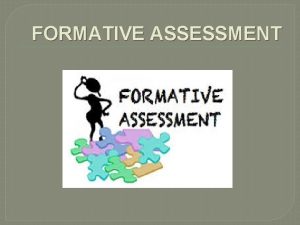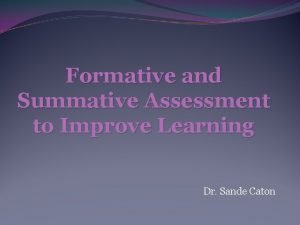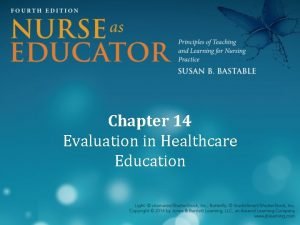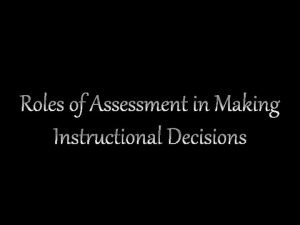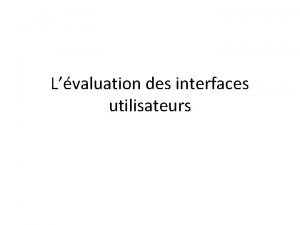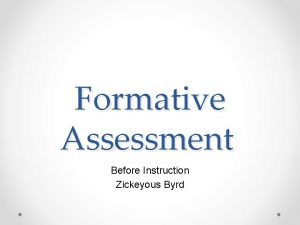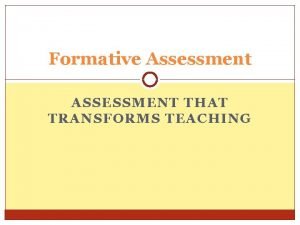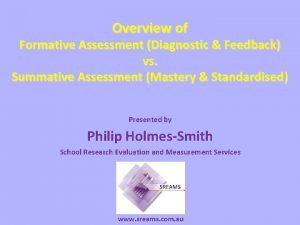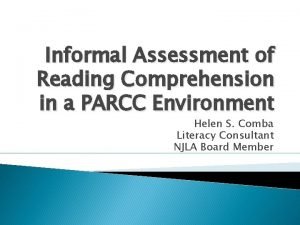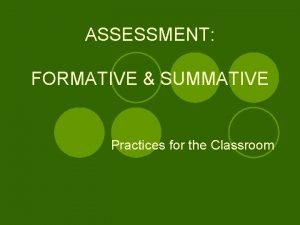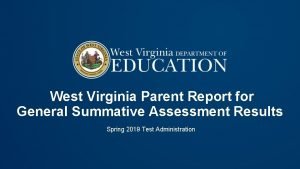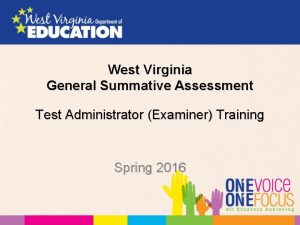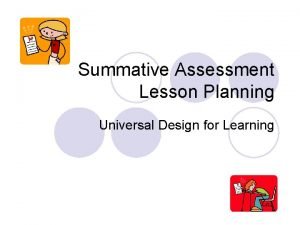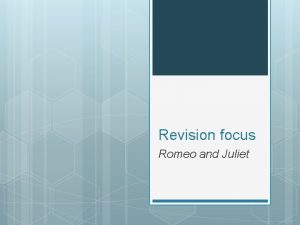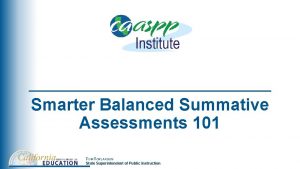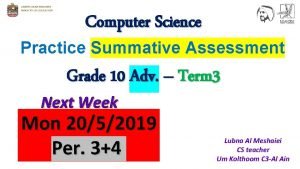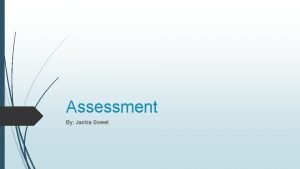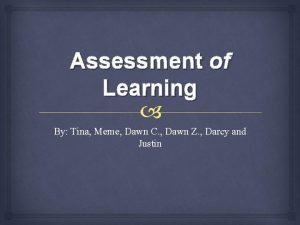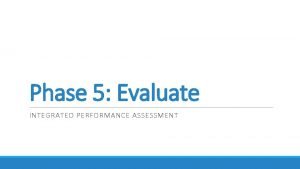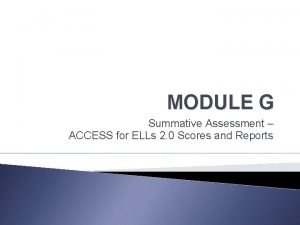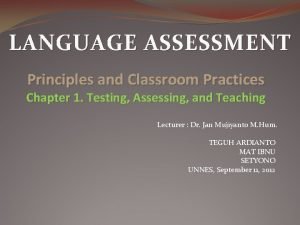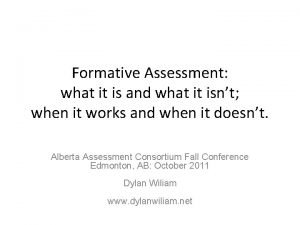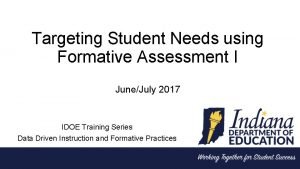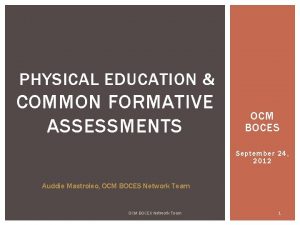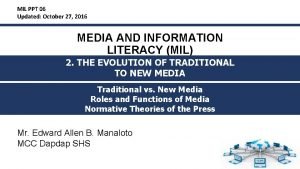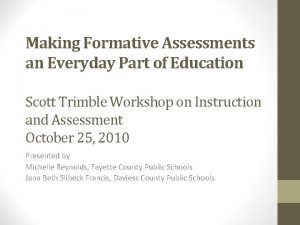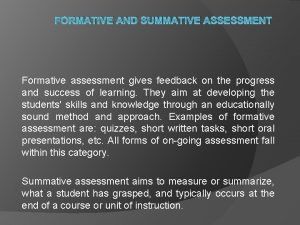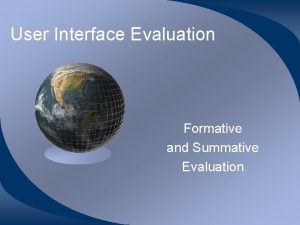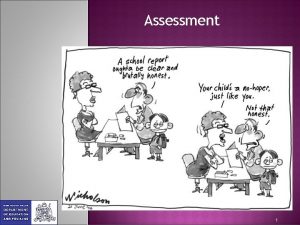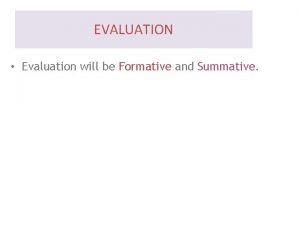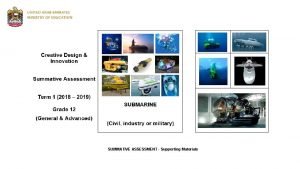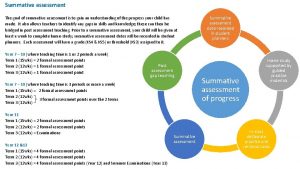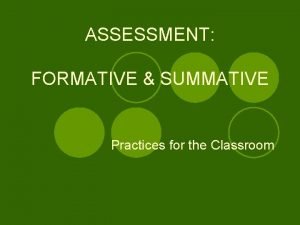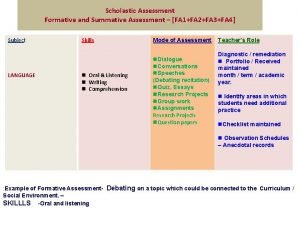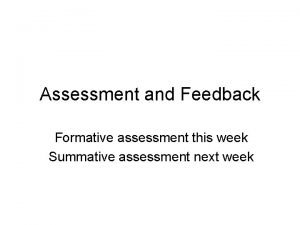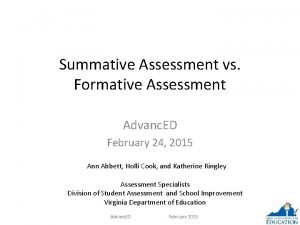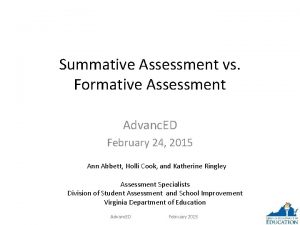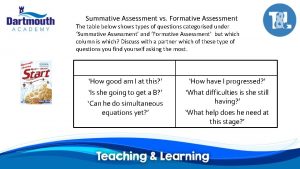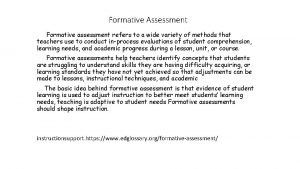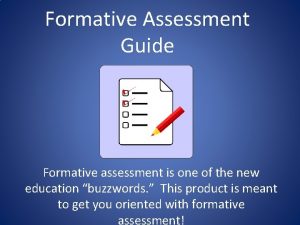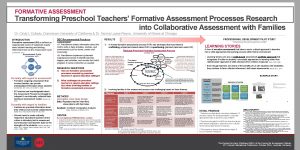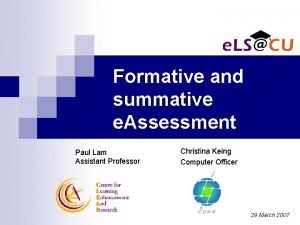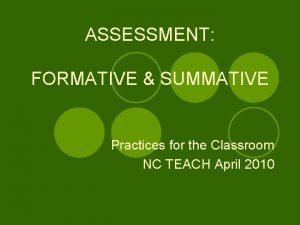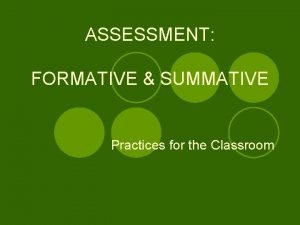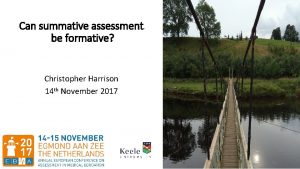Summative assessment Assessment for learning Formative assessment Assessment






























- Slides: 30


Summative assessment Assessment for learning Formative assessment Assessment of learning Assessment as learning

Assessment for Learning Bath Course Dr Karen Angus-Cole Curriculum Development Officer K. L. Angus-Cole@bath. ac. uk

Learning objectives • compare assessment of learning with assessment for learning (Af. L) • discuss the benefits and challenges associated with Af. L • justify the use of specific Af. L strategies in different contexts

Learning objectives • compare assessment of learning with assessment for learning (Af. L) • discuss the benefits and challenges associated with Af. L • justify the use of specific Af. L strategies in different contexts

Summative assessment Assessment for learning Formative assessment Assessment of learning Assessment as learning

Summative assessment • a task • occurs at the end of the learning and teaching unit • aims to determine where a student is against a set of benchmarks grade is given • often high stakes • essentially synonymous with assessment of learning


Traditional teaching approach Teaching Summative assessment Assessment of learning

Formative assessment • a process • often occurs during the learning and teaching unit • aims to determine where a student is in their understanding • informs the next steps • low stakes • synonymous with assessment for learning? ? ?

The Af. L process

The Af. L process • an activity is carried out by learners • the activity assesses learner’s progress against a specific learning objective • teachers ascertain to what extent learner has progressed against the learning objective • feedback is given to learner that allows them to progress in their learning • the next teaching episode is informed by where the learner is

Formative teaching approach Teaching Formative assessment Assessment for learning Teachinginformed by formative assessment Summative assessment Formative assessment Assessment of learning Assessment for learning

The Af. L process Simple oral questioning during teaching is a great Af. L activity • Learners answer the question • The teacher gets information about the learner’s progress, based on their answer • Oral feedback can be given immediately to the learner that allows them to progress in their learning • The feedback allows the learner to move forward and progress

Assessment as learning • essentially Af. L done really well! • learners work out for themselves what success looks like, with the teacher facilitating the process • learners determine where they are in their own learning encourages self-reflection • common approaches are: - self assessment - peer assessment - collaborative creation of success criteria for an assessment

Assessment as learning • Students co-creating success criteria for a task with the teacher • Students completing the task • Peer assessing against the success criteria, providing feedback that students act on to improve

Comparing Ao. L and Af. L Ao. L Af. L

Comparing Ao. L and Af. L During teaching Graded Feedback given Ao. L Proves understanding Af. L After teaching Teacher responsible for determining student progress Improves understanding


Assessment of learning • Teacher assesses student learning after teaching Assessment for learning • Teacher assesses student learning during teaching • Feedback provided to student to help student to improve Assessment as learning • Students reflect on their own progress or progress of others • Students identify next steps required to improve

Learning objectives • compare assessment of learning with assessment for learning (Af. L) • discuss the benefits and challenges associated with Af. L • justify the use of specific Af. L strategies in different contexts

Your own experience Share your own experiences of using Af. L strategies Benefits? Challenges?

Benefits and challenges https: //www. youtube. com/watch? v=ZVFw. Qzl. VFy 0 1. What type of assessment activity might this be classed as? 2. What are the benefits of this activity? 3. What would be the challenges associated with carrying out this activity effectively?

Benefits and challenges More examples…reflect on: 1. Why could this be classed as an Af. L or Aa. L activity? 2. What are the benefits of this activity? (for students; for the teacher) 3. What would be the challenges associated with carrying out this activity effectively? (learning environment, learners, workload)

Exit passes Each student is given a small sheet of paper with 3 -4 key questions that ascertain the extent of students’ learning These are filled in by students at the end of a lesson and collected by the teacher as the students leave Why could this be classed as an Af. L or Aa. L activity? What are the benefits of this activity? (for students; for the teacher) What would be the challenges associated with carrying out this activity effectively? (learning environment, learners, workload) 1. Why…? 2. What…? 3. How…?

Exit passes Each student is given a small sheet of paper with 3 -4 key questions that ascertain the extent of students’ learning 1. Why…? 2. What…? 3. How…? These are filled in by students at the end of a lesson and collected by the teacher as the students leave Why could this be classed as an Af. L or Aa. L activity? What are the benefits of this activity? (for students; for the teacher) What would be the challenges associated with carrying out this activity effectively? (learning environment, learners, workload)

Learning objectives • compare assessment of learning with assessment for learning (Af. L) • discuss the benefits and challenges associated with Af. L • justify the use of specific Af. L strategies in different contexts

Your own context One size does not fit all! - You all have different learners with different backgrounds - You all teach different subjects - You each have different experiences yourself Reflect on the examples of Af. L/Aa. L activities we have covered today. • Which activities have you already used? • Which activities could you use in your own teaching and why? • Which activities would you not use and why?

Learning objectives • compare assessment of learning with assessment for learning (Af. L) • discuss the benefits and challenges associated with Af. L • justify the use of specific Af. L strategies in different contexts

References Dylan Wiliam, Embedded Formative Assessment, Solution Tree Press Ruth Dann (2014) Assessment as learning: blurring the boundaries of assessment and learning for theory, policy and practice. Assessment in Education: principles, Policy & Practice, 21: 2, 149 -166
 Summative and formative assessment
Summative and formative assessment التحصيلي
التحصيلي Evaluation in healthcare education
Evaluation in healthcare education Diagnostic formative summative
Diagnostic formative summative Formative vs. summative usability evaluation
Formative vs. summative usability evaluation Formative vs. summative assessment venn diagram
Formative vs. summative assessment venn diagram Summative and formative assessment
Summative and formative assessment What is diagnostic assessment in teaching
What is diagnostic assessment in teaching What is formative assessment
What is formative assessment Formative vs summative
Formative vs summative Wv general summative assessment
Wv general summative assessment Wv test administrator
Wv test administrator Wv airast secure browser
Wv airast secure browser Lesson plan for summative test
Lesson plan for summative test Romeo and juliet summative assessment
Romeo and juliet summative assessment Objectives of summative evaluation
Objectives of summative evaluation Http://www.caaspp.org
Http://www.caaspp.org Summative assessment for the term 3 grade 10
Summative assessment for the term 3 grade 10 Sweet evaluation
Sweet evaluation Meme about summative assessment
Meme about summative assessment Ipa integrated performance assessment
Ipa integrated performance assessment Summative assessment
Summative assessment Diberikan suatu fungsi dengan persamaan y=2x-√x
Diberikan suatu fungsi dengan persamaan y=2x-√x What is summative evaluation
What is summative evaluation Summative assessment
Summative assessment Formative assessment process
Formative assessment process Formative assessments in physical education
Formative assessments in physical education Mil ppt
Mil ppt Mil curriculum guide
Mil curriculum guide People as media and people in media venn diagram
People as media and people in media venn diagram Scott trimble workshop
Scott trimble workshop
